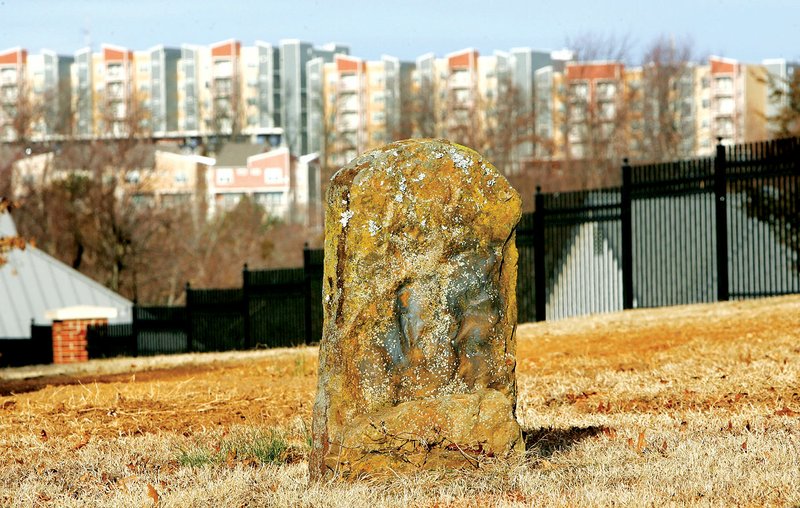Segregation once extended even beyond death, when white cemeteries were closed to African-Americans.
During the time of slavery, slaves were buried near their masters. But with freedom came African-American cemeteries scattered across the South. Many remain, many are unmarked, and many have been lost to time.
“Oak Cemetery: A Forgotten Place” records the history of just such a cemetery in Fayetteville. The 2013 film, by University of Arkansas journalism students Tiffany King and John Cooper, was aired recently at the Yvonne Richardson Community Center in Fayetteville. The event was co-sponsored by the center and Compassion Fayetteville, both in recognition of Black History Month and as an act of compassion.
The Compassion Fayetteville group sprang from the Fayetteville Forward Economic Accountability Council Inclusion Group, reminded Pattie Williams, facilitator of the Compassion team.
“We attempt to embrace other cultures and broaden our understanding of ‘community,’” she said.”To me, at the heart of compassion is networking and that person-to-person interaction.”
The board members of the Yvonne Richardson Center also want to help the community that has given them so much, said Charles Ballentine, a member of the board.
“We want to reach out to our neighbors with an open hand, asking, ‘How can we help you?’ We’re here to take care of the community.”
D’andre Jones, assistant director of the Yvonne Richardson Community Center and chairman of the event, said that events such as the film screening are important to bring African-American history — and the history of Fayetteville as a whole — to the forefront.
“We know education is the key to open a lot of doors,” he said.
Since the presentation of the film about Oak Cemetery, several community groups have come forward to offer help with caring for the grave sites, Williams said.
Oak Cemetery was created when Stephen K. Stone, one of the founding fathers of Fayetteville, sold a plot of land for $10 “to the colored people of Washington County” on July 4, 1867, according to J.B. Hogan, a local historian.
African-Americans at the time populated the area known as “Tin Cup” or “the Holler” in a hollow behind the 1904 Washington County Courthouse, “between the business section of Fayetteville and at the foot of the neighboring Mount Sequoyah,” the film described. Hogan said the cemetery — behind the Fayetteville National Cemetery on the southeastern side — was not built in the Holler because the land wasn’t conducive to cemeteries. Stone was the richest man in Fayetteville, Hogan added, so “everything was his land,” and that was the plot he offered for the cemetery.
“It always seemed like a dumping ground, not a cemetery,” said Betty Davis, a native of Fayetteville. “That was my early feeling about putting your loved one’s body there. ‘Out of sight, out of mind.’”
The film shows Davis visiting the cemetery, which she had not done for years.
”I would say this is a grave marker from a time when people didn’t have money to buy headstones,” she said, using her cane to point to what look like simple bricks. “But they had to have some way to identify a family’s grave.
“There was just one mortuary that would accept blacks (and) Sunday was funeral day,” she recalled. Members of the black congregations of Baptists and Methodists went to the cemetery.
On the last day of filming for the documentary, the filmmakers were with Davis in the cemetery, King said at the event. As the group was about to leave, Davis found her great-grandfather’s grave: Wm. Davis (1845-1912). It had fallen and been hidden under a bush for many years.
The film shows the moment, with Davis leaning on his grave marker, crying. “I thought it was all gone. My great-grandmother was buried next to him someplace,” she said as she looked around.
“This is the individual who started this family. Grandpa, God bless you. I thank you for having started this family. We all owe you. God is good.”
The cemetery also holds the grave of Lemule “Lem” McPherson (1880 to 1928), the first Fayetteville Police officer killed in the line of duty. Anything that went on in the black community had to be settled within the community — the only jurisdiction in which McPherson, the city’s first African-American officer, had authority, the film relates.
Everett Williams, a resident of Tin Cup Holler and a well-known bootlegger, was released from jail after nine months. He thought men had been seeing is wife while he was in jail — including McPherson. Williams stole a shotgun and killed McPherson. He was later captured by other officers but escaped. Finally he turned himself in, was found guilty by a jury of 12 white men and sentenced to 21 years in the Arkansas State Penitentiary.
McPherson, 48, was buried in Oak Cemetery in an unmarked grave, his story not told for more than 80 years.
Today, a marker erected by the Fayetteville Police Department marks McPherson’s grave. But many graves in the cemetery remain unmarked; time or vandals have destroyed the markers or families of the deceased could not afford a marker.
“It was a community that was made by people who had suffered,” Jessie Bryant, who served 17 years as a justice of the peace, said of the black community in Fayetteville after the Civil War. “This community was set up by freed slaves. That’s awesome. These are people who had nothing, and they were able to create and make something. I’m proud of that. And this is why I don’t want their lives to be in vain.”
“We need to remember those names (of those buried in the cemetery) and the plight they went through,” said Henry Childress, president of the all-volunteer Oak Creek Cemetery Association.
Go & Do
Oak Cemetery
Community Group
Time: 6:30 p.m. second Tuesday of each month
Where: St. James United Methodist Church, 5 N. Willow Ave. in Fayetteville
Needs: Labor, funds, a paved road, fencing
NAN Our Town on 02/27/2014

